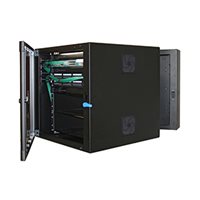How Power over Ethernet Will Impact Enterprise Networks and How To Support It
November 11, 2022
According to the Cisco Annual Internet Report (2018-2023), global M2M connections will grow 2.4-fold, from 6.1 billion in 2018 to 14.7 billion by 2023, and there will be 1.8 M2M connections for each member of the global population by 2023. Additionally, connected home applications, such as home automation, home security and video surveillance, connected white goods, and tracking applications, will represent 48 percent, or nearly half, of the total M2M connections by 2023.
For the network engineers responsible for designing and managing the enterprise and premise networks upon which these and countless other connections will depend, especially when it comes to ensuring availability and speed of these networks to business users, there are a number of technologies that should be considered when planning network upgrades.
 In a recent white paper from Chatsworth Products (CPI), we summarize one such technology—Power over Ethernet (PoE)—and its impact on the physical premise network, while highlighting the most recent advancements in cable management and equipment storage that will help with network upgrades and ensure a smooth, reliable deployment of PoE-enabled systems that are poised to become instrumental in the fast-rising world of M2M connections highlighted above and beyond.
In a recent white paper from Chatsworth Products (CPI), we summarize one such technology—Power over Ethernet (PoE)—and its impact on the physical premise network, while highlighting the most recent advancements in cable management and equipment storage that will help with network upgrades and ensure a smooth, reliable deployment of PoE-enabled systems that are poised to become instrumental in the fast-rising world of M2M connections highlighted above and beyond.
When PoE was introduced in 2003, the basic concept was to deliver power over a network connection to end devices, eliminating the need for a separate power connection. Currently deployed PoE now delivers up to 60 Watts of power to equipment, with some newly emerging advances pushing that threshold even higher to 90-100 Watt systems, where all 4-pairs (8 conductors) carry power. With these new thresholds, PoE now easily powers Voice over Internet Protocol (VoIP) desk phones, wireless access points (APs) and basic security cameras.
Enhanced PoE++, introduced only in the last few years, creates two additional types, or power ranges, for 60 Watts and up to 100 Watts per connection, thus extending the possibilities to power other end devices such as high bandwidth APs, pan-tilt-zoom security cameras, access control systems and Internet of Things (loT) sensors, and eventually large kiosk displays and computers as more PoE-enabled devices become available.
Of course, for enterprises to reap these benefits, it’s going to take a series of network upgrades—and improvements to the underlying ICT infrastructure that supports these networks—to ensure a smooth, reliable deployment of the latest PoE-enabled systems.
How to Support PoE++ in the Premise Network
When it comes to cable management, new structured cabling installations should consider a 25 Gbps or 40 Gbps fiber or Category 8 F/UTP or U/UTP backbone and 10 Gbps Category 6A UTP or Category 8 F/UTP or U/UTP horizontal connections. However, existing Category 5e and Category 6 UTP horizontal cabling can support 5 Gbps network connections and PoE++ under certain conditions.
There are several advancements in cable management to address these evolving needs. First, you can easily and quickly align the transitions between vertical cable managers alongside equipment racks and overhead cable trays. Cable runway, or ladder rack, is now available with movable cross members. This lets you adjust the position of a cross member if it interferes with the transition of cables between the vertical manager and overhead pathway, as shown below. You can place radius drops exactly where they need to be to path cable into the vertical manager. Additionally, easy-to-use toolless pathway dividers allow you to maintain space between cable bundles within the pathway.

When it comes to racks and cabinets and supporting new PoE-related gear, standard premise networks today tend to include PoE switches with higher speed device connections. These switches are generally heavier than non-PoE switches and require a larger UPS or battery backup to provide longer runtimes with higher power end equipment. That may mean more heat exhausted from equipment. Bonding is more important with PoE switches and F/UTP, U/UTP, STP shielded cables, while physical security for equipment is another growing concern. You may need to place equipment in a shared location or retrofit an enclosure around existing equipment.
 There are several advances in equipment support to address these concerns as well. First, wall-mount enclosures like the one pictured here can provide security for network equipment in a shared space. Look for enclosures that are UL Listed under the NWIN category. This means they meet the ANSI/UL 2015, the standard for Audio/Video, Information and Communication Technology Equipment Cabinet, Enclosure and Rack Systems, which requires a load test and integrated bonding. In general, the loads supported by wall cabinets have increased to accommodate the heavier switches, UPS and battery backups that support high power PoE. The integrated bonding point makes connection to the telecommunications bonding bus bar easier so you can bond switches and patch panels.
There are several advances in equipment support to address these concerns as well. First, wall-mount enclosures like the one pictured here can provide security for network equipment in a shared space. Look for enclosures that are UL Listed under the NWIN category. This means they meet the ANSI/UL 2015, the standard for Audio/Video, Information and Communication Technology Equipment Cabinet, Enclosure and Rack Systems, which requires a load test and integrated bonding. In general, the loads supported by wall cabinets have increased to accommodate the heavier switches, UPS and battery backups that support high power PoE. The integrated bonding point makes connection to the telecommunications bonding bus bar easier so you can bond switches and patch panels.
Ultimately, there are a number of new networking technologies to consider for upgrades as you transition your premise network to support an ever increasing demand for bandwidth. Don’t forget to assess your physical network, your structured cabling, cable management practices and physical security as part of the process. Improved cable management products allow you to place supports exactly where they are required and easily separate cables to manage heat while new types of wall-mount enclosures create robust, secure spaces for your IT equipment and can easily retrofit over existing equipment or be placed in meeting rooms and other spaces where stronger network connections are required.
To learn more about these PoE-related advancements, be sure to read the full white paper from Chatsworth Products.
Posted by Jeff Cihocki, Content Manager at 11/11/2022 8:03:31 AM